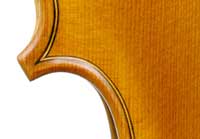|
Ref : 0809
A fine violin by
|

go to Home Page see more Violins |
Johannes Hendrik Davis was born on a farm in Namaqualand in 1918 and taught himself from books to make violins. The story goes that his father was also a self-taught violinmaker who died when Johannes was only two years old. Hence the little boy didn't learn from his father, but his passion for violins led him later in life to study the craft in depth and to produce several really serious instruments that conform to very high standards. He passed away in October 2013.Johannes H. Davis is the father of Mervin Davis (b. 1955), a foremost guitar maker (photo)with a big international following . Mervin took his first steps in guitar making with skills learnt from his father and his work is characterized by exceptionally fine craftsmanship - something largely acquired from his father. Mervin made a few violins early in his career, but returned to his first love - guitars.
This was Johannes H. Davis's fourth violin, made in 1983. In this case the instrument was completed by Mervin, who traced the purfling and varnished it. Both the scroll design and f-hole shape depart from norms, but rather than being mere fanciful personalizations, these were carefully determined and planned. In the case of the f-holes, the exact surface of the opening was meticulously calculated, demonstrating a serious approach to a complex subject.
Everything about this violin demonstrates refinement. Measurements and thicknesses are correct. The choice of woods is excellent - the top is of really good quality finely grained tone spruce. The two-piece back and sides are of nicely flamed maple with a medium curl. The elongated f-holes are of original design, but elegant and attractive, albeit peu commun. What strikes one is the very tidy work on the corners - following a French tradition of a somewhat angular shape. Purfling is nicely traced with good mitres. The oil-based varnish is a pale golden honey colour of high transparency, allowing for good interaction between the wood and light - altogether attractive.
This violin is in very good condition. An impact fracture along the bass side of the top has been superbly repaired and is almost invisible. This is clear from the bassbar or bridge area. Furthermore, the central seam in the back has been secured in the button area for about 5 cm and is perfectly secure, being held by the neck and the neck block.
This instrument is well-toned - the g-string is particularly pleasing with a rich focused response, which holds true for this violin in its entirety. It is indeed a very good instrument, deserving respect and admiration.
 |
 |
 |
||
 |
Dimensions : Length of back: 35.7 cm
Condition : Very good condition. A fracture along the bass side of the top has been superbly repaired and is virtually invisible. The central seam in the back has been secured at the button area. All is secure.
Provenance : Withheld
Price : Withheld
 |
 |
 |
 |
 |
 |
 |
 |
 |
 |
 |
 |
|||||
 |
 |